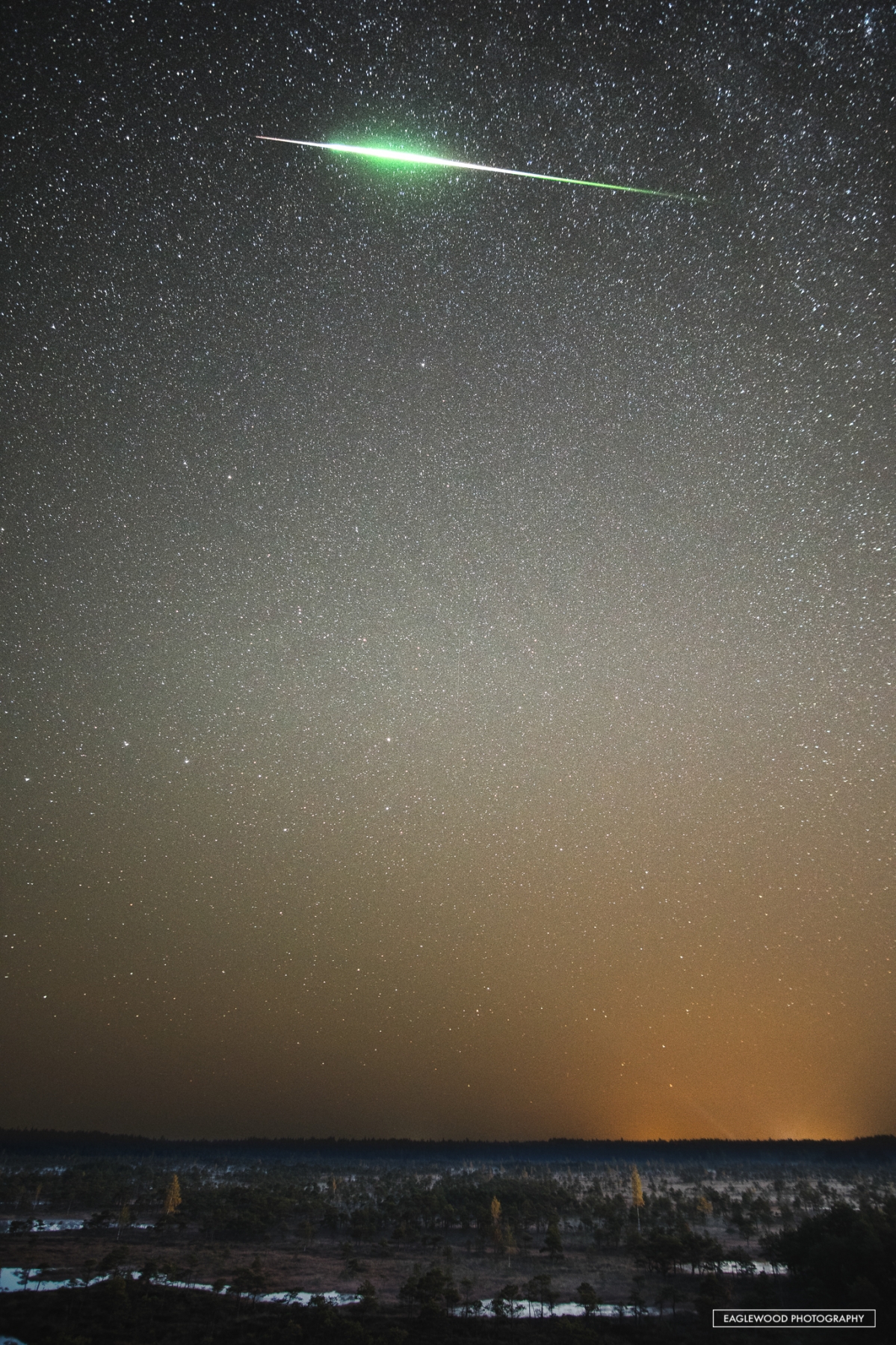 This incredible fireball was captured by Arvids Baranovs on September 25 at 21:09 UT from the raised bog of Ķemeri in Latvia. © Arvids Baranovs and Eaglewood Photography eaglewoodfilms.com
This incredible fireball was captured by Arvids Baranovs on September 25 at 21:09 UT from the raised bog of Ķemeri in Latvia. © Arvids Baranovs and Eaglewood Photography eaglewoodfilms.comMeteor activity increases in October when compared to September. A major shower (the Orionids) is active all month long and there are also many minor showers to be seen. Both branches of the Taurids become more active as the month progresses, providing slow, graceful meteors to the nighttime scene. The Orionids are the big story of the month reaching maximum activity on the 22nd. This display can be seen equally well from both hemispheres which definitely helps out observers located in the sporadic-poor southern hemisphere this time of year. Sporadic activity is still good as seen from the northern hemisphere. In the southern hemisphere though, the sporadic activity is near its annual nadir.
During this period the moon will reach its full phase on Friday October 6th. At this time the moon will be located opposite the sun and will lie above the horizon all night long. This weekend the waxing gibbous moon will set during the early morning hours, allowing meteor observers a few hours of dark skies before the first light of dawn. The estimated total hourly meteor rates for evening observers this week is near 3 for those viewing from the northern hemisphere and 2 for those located south of the equator. For morning observers the estimated total hourly rates should be near 16 as seen from mid-northern latitudes and 13 from the southern tropics. The actual rates will also depend on factors such as personal light and motion perception, local weather conditions, alertness and experience in watching meteor activity. Evening rates are reduced this week due to moonlight. Note that the hourly rates listed below are estimates as viewed from dark sky sites away from urban light sources. Observers viewing from urban areas will see less activity as only the brighter meteors will be visible from such locations.
The radiant (the area of the sky where meteors appear to shoot from) positions and rates listed below are exact for Saturday night/Sunday morning September 30/October 1. These positions do not change greatly day to day so the listed coordinates may be used during this entire period. Most star atlases (available at science stores and planetariums) will provide maps with grid lines of the celestial coordinates so that you may find out exactly where these positions are located in the sky. A planisphere or computer planetarium program is also useful in showing the sky at any time of night on any date of the year. Activity from each radiant is best seen when it is positioned highest in the sky, either due north or south along the meridian, depending on your latitude. It must be remembered that meteor activity is rarely seen at the radiant position. Rather they shoot outwards from the radiant so it is best to center your field of view so that the radiant lies at the edge and not the center. Viewing there will allow you to easily trace the path of each meteor back to the radiant (if it is a shower member) or in another direction if it is a sporadic. Meteor activity is not seen from radiants that are located far below the horizon. The positions below are listed in a west to east manner in order of right ascension (celestial longitude). The positions listed first are located further west therefore are accessible earlier in the night while those listed further down the list rise later in the night.
These sources of meteoric activity are expected to be active this week.
.
Experienced observers are urged to be on the lookout for any activity from the October Capricornids (OCC). These meteors are possibly related to lost comet D/1978 R1 (Haneda-Campos). If the comet still exists it would have reached perihelion in November 2016. A moderate display of bright meteors was seen from Australia on October 3, 1972. Other attempts at observing these meteors were less successful. Moonlight will interfere during this period but observers are still urged to monitor the evening sky this week for any very slow meteors radiating from the border of Capricornus and Aquila near the position 20:12 (303) -10. This position is roughly 4 degrees northwest of the naked eye double star known as Algedi (alpha2 Capricorni). This position is best placed near 2000 local summer time (LST) when the radiant lies highest above the horizon. While this area of the sky is fairly well placed for northern observers, it is much more favorably placed for those south of the equator where it lies much higher in the sky. Like the Daytime Sextantids mentioned below, any observations of these stream (either positive or negative) would be important to our understanding of these streams. Maximum activity is predicted to occur on October 2nd.
The Southern Taurids (STA) are active from a large radiant centered near 01:20 (020) +06. This position lies in southeastern Pisces, 2 degrees southeast of the faint star known as zeta Piscium. These meteors may be seen all night long but the radiant is best placed near 0200 LST when it lies on the meridian and is located highest in the sky. Rates at this time should be near 3 per hour regardless of your location. With an entry velocity of 27 km/sec., the average Southern Taurid meteor would be of slow velocity.
The last of the September Epsilon Perseids (SPE) will be seen this week. The radiant is currently located at 04:49 (072) +41. This position lies on the Perseus/Auriga border, 3 degrees west of the 3rd magnitude star known as Haedus II (eta Aurigae). The radiant is best placed near 0500 LST, when it lies highest above the horizon. Rates are expected to be less than 1 per hour no matter your location. With an entry velocity of 65 km/sec., most activity from this radiant would be swift.
The Orionids (ORI) are active from a radiant located at 04:57 (074) +17, which places it in central Taurus, 4 degrees east of the 1st magnitude orange star known as Aldebaran (alpha Tauri). This area of the sky is best placed in the sky during the last hour before dawn, when it lies highest above the horizon in a dark sky. Current rates would be near 2 per hour no matter your location. With an entry velocity of 67 km/sec., most activity from this radiant would be of swift speed.
The nu Eridanids (NUE) were co-discovered by Japanese observers using SonotoCo and Juergen Rendtel and Sirko Molau of the IMO. Activity from this long-period stream stretches from August 24 all the way to November 16. A very shallow maximum occurred near September 8. The radiant currently lies at 05:35 (084) +08, which places it in western Orion, 3 degrees northeast of the 2nd magnitude star known as Bellatrix (gamma Orionis). This area of the sky is best seen during the last dark hour before dawn when the radiant lies highest in a dark sky. Current rates are expected to be near 1 per hour during this period no matter your location. With an entry velocity of 67 km/sec., the average meteor from this source would be of swift velocity. Some experts feel that these meteors are early members of the Orionid shower, which peaks on October 22.
The Daytime Sextantids (DSX) are not well known due to the fact that the radiant lies close to the sun and these meteors are only visible during the last couple of hours before dawn. The radiant is currently located at 10:24 (156) -02. This position lies in central Sextans, 4 degrees southeast of the 4th magnitude star known as alpha Sextantis. This area of the sky is best placed in the sky during the last hour before dawn, when it lies highest above the horizon in a dark sky. Current rates would be most likely less than 1 per hour no matter your location. Spotting any of this activity would be a notable accomplishment. With an entry velocity of 33km/sec., most activity from this radiant would be of medium-slow speed.
As seen from the mid-northern hemisphere (45N) one would expect to see approximately 10 sporadic meteors per hour during the last hour before dawn as seen from rural observing sites. Evening rates would be near 2 per hour. As seen from the tropical southern latitudes (25S), morning rates would be near 7 per hour as seen from rural observing sites and 1 per hour during the evening hours. Locations between these two extremes would see activity between the listed figures. Evening rates are reduced this week due to moonlight.
The list below offers the information from above in tabular form. Rates and positions are exact for Saturday night/Sunday morning except where noted in the shower descriptions.
| SHOWER | DATE OF MAXIMUM ACTIVITY | CELESTIAL POSITION | ENTRY VELOCITY | CULMINATION | HOURLY RATE | CLASS |
| RA (RA in Deg.) DEC | Km/Sec | Local Summer Time | North-South | |||
| October Capricornids (OCC) | Oct 02 | 20:12 (303) -10 | 10 | 20:00 | <1 – <1 | IV |
| Southern Taurids (STA) | Oct 29-Nov 03 | 01:20 (020) +06 | 27 | 02:00 | 3 – 3 | II |
| September Epsilon Perseids (SPE) | Sep 10 | 04:49 (072) +41 | 65 | 05:00 | <1 – <1 | II |
| Orionids (ORI) | Oct 22 | 04:57 (074) +17 | 67 | 05:00 | 2 – 2 | I |
| nu Eridanids (NUE) | Sep 08 | 05:35 (084) +08 | 67 | 06:00 | 1 – 1 | IV |
| Daytime Sextantids (DSX) | Sep 29 | 10:24 (156) -02 | 33 | 11:00 | <1 – <1 | IV |


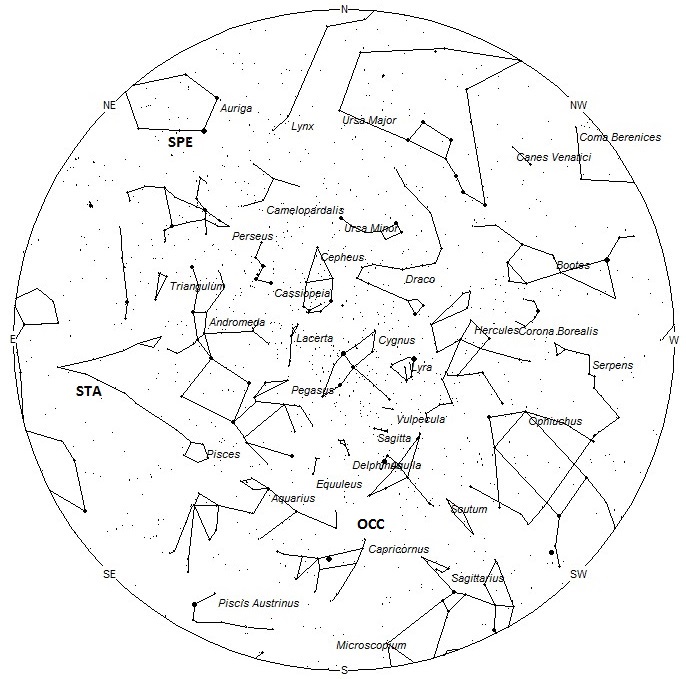
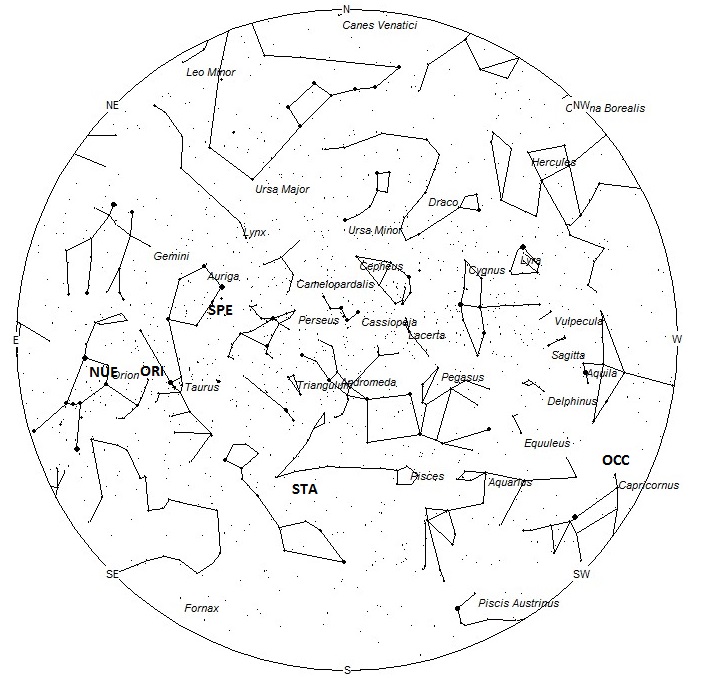
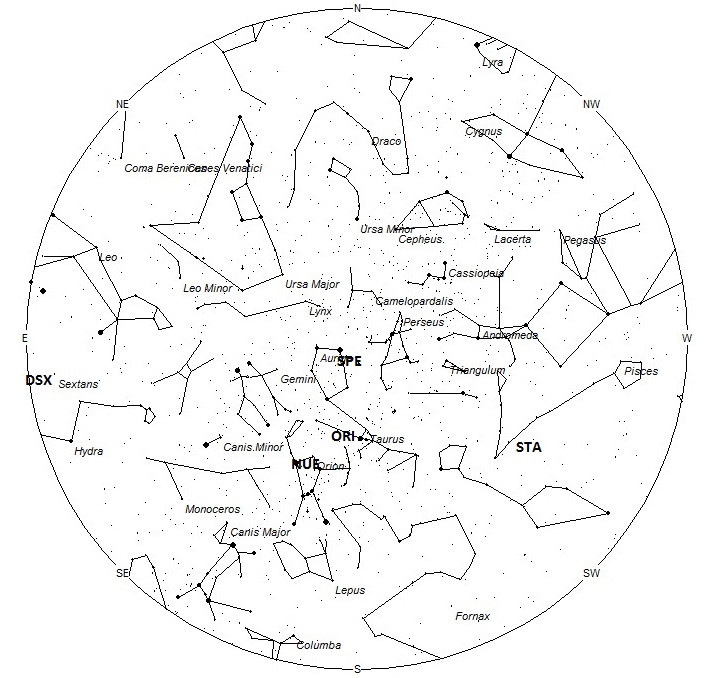

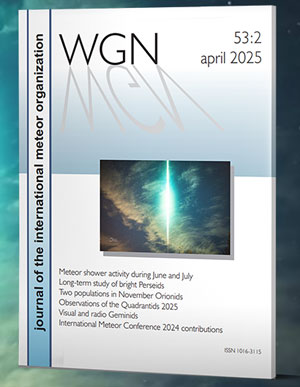
 You saw something bright and fast? Like a huge shooting star? Report it: it may be a fireball.
You saw something bright and fast? Like a huge shooting star? Report it: it may be a fireball.  You counted meteors last night? Share your results with us!
You counted meteors last night? Share your results with us!  You took a photo of a meteor or fireball? You have a screenshot of your cam? Share it with us!
You took a photo of a meteor or fireball? You have a screenshot of your cam? Share it with us!  You caught a meteor or fireball on video? Share your video with us!
You caught a meteor or fireball on video? Share your video with us!